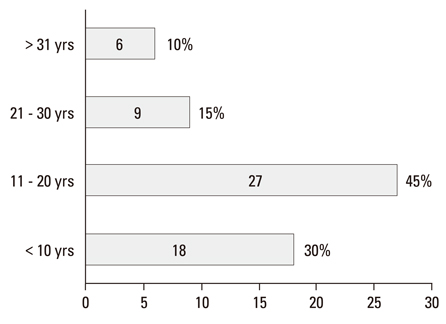Comparison of Clinical Characteristics between Primary and Secondary Paranasal Mucoceles
- Affiliations
-
- 1Department of Otorhinolaryngology-Head and Neck Surgery, Kangbuk Samsung Hospital, Sungkyunkwan University School of Medicine, Seoul, Korea. fess0101@hanmail.net
- KMID: 1071426
- DOI: http://doi.org/10.3349/ymj.2010.51.5.735
Abstract
- PURPOSE
Paranasal sinus mucocele is a benign, expansile mass which can occur as a result of trauma or spontaneous obstruction of a sinus tract. The purpose of this study was to describe and compare the clinical characteristics of primary mucoceles occurring in patients with no previous sinus surgery history or known cause of mucoceles and secondary mucoceles resulting as a complication following endoscopic sinus surgery or the Caldwell-Luc operation.
MATERIALS AND METHODS
We performed a retrospective chart review of 33 cases of primary mucoceles and 60 cases of secondary mucoceles which were diagnosed and surgically corrected between 1996 and 2008.
RESULTS
The most common presenting symptoms in primary mucoceles were nasal obstruction (19.4%) and rhinorrhea (17.7%). In secondary mucoceles, the most common symptoms were cheek pain (31.7%) and nasal obstruction (18.3%). The most common origins of primary mucoceles were the ethmoid sinus (45.5%) and the maxillary sinus (18.2%). In secondary mucoceles, the maxillary sinus was the most common site (86%), followed by the ethmoid sinus (7.1%). All patients with secondary mucoceles had a history of sinus surgery.
CONCLUSION
The maxillary sinus was the most common site of secondary mucoceles while the ethmoid sinus was the most common origin of primary mucoceles. Cases of secondary mucoceles that occurred following sinus endoscopic surgery developed more frequently in the ethmoid sinus than in those following the Caldwell-Luc procedure, therefore, we suggest that the incidence of maxillary sinus mucoceles in the Asian population would decrease as the rate of endoscopic sinus surgery increases.
MeSH Terms
Figure
Cited by 3 articles
-
Mucocele of the Nasal Septum: Case Report and Review of the Literature
Dong Hoon Lee, John Jae Woon Lee, Wan Seok Cho, Sang Chul Lim
J Rhinol. 2015;22(2):112-115. doi: 10.18787/jr.2015.22.2.112.A Case of Primary Septated Mucocele of Maxillary Sinus
Juyong Chung, Young Chang Sim, Dam Ho Lee, Jae Hoon Lee
Korean J Otorhinolaryngol-Head Neck Surg. 2016;59(12):865-868. doi: 10.3342/kjorl-hns.2016.59.12.865.Principal Clinical Factors Predicting Therapeutic Outcomes After Surgical Drainage of Postoperative Cheek Cysts: Experience From a Single Center
Sung-Woo Cho, Hyun Jung Lim, Yoonjae Song, Young Kang, Jae Hyun Lim, Yung Jin Jeon, Doo Hee Han, Tae-Bin Won, Dong-Young Kim, Hyun Jik Kim
Clin Exp Otorhinolaryngol. 2019;12(1):79-85. doi: 10.21053/ceo.2018.00528.
Reference
-
1. Busaba NY, Salman SD. Maxillary sinus mucoceles: clinical presentation and long-term results of endoscopic surgical treatment. Laryngoscope. 1999. 109:1446–1449.
Article2. Caylakli F, Yavuz H, Cagici AC, Ozluoglu LN. Endoscopic sinus surgery for maxillary sinus mucoceles. Head Face Med. 2006. 2:29.
Article3. Busaba NY, Kieff D. Endoscopic sinus surgery for inflammatory maxillary sinus disease. Laryngoscope. 2002. 112:1378–1383.
Article4. Kim SS, Kang SS, Kim KS, Yoon JH, Lee JG, Park IY. Clinical characteristics of primary paranasal sinus mucoceles and their surgical treatment outcomes. Korean J Otolaryngol-Head Neck Surg. 1998. 41:1436–1439.5. Hasegawa M, Kuroishikawa Y. Protrusion of postoperative maxillary sinus mucocele into the orbit: case reports. Ear Nose Throat J. 1993. 72:752–754.
Article6. Lund VJ, Milroy CM. Fronto-ethmoidal mucoceles: a histopathological analysis. J Laryngol Otol. 1991. 105:921–923.7. Marks SC, Latoni JD, Mathog RH. Mucoceles of the maxillary sinus. Otolaryngol Head Neck Surg. 1997. 117:18–21.
Article8. Arrué P, Kany MT, Serrano E, Lacroix F, Percodani J, Yardeni E, et al. Mucoceles of the paranasal sinuses: uncommon location. J Larlyngol Otol. 1998. 112:840–844.
Article9. Song HM, Park HW, Chung YS, Jang YJ, Lee BJ. Primary mucoceles of the maxillary sinus. Korean J Otolaryngol-Head Neck Surg. 2006. 49:47–51.10. Kaneshiro S, Nakajima T, Yoshikawa Y, Iwasaki H, Tokiwa N. The postoperative maxillary cyst: report of 71 cases. J Oral Surg. 1981. 39:191–198.11. Athevino CC, Atherino TC. Maxillary sinus mucocele. Arch Otolaryngol. 1984. 110:200–202.12. Barzilai G, Greenberg E, Uri N. Indications for the Caldwell-Luc approach in the endoscopic era. Otolaryngol Head Neck Surg. 2005. 132:219–220.13. Har-El G, Balwally AN, Lucente FE. Sinus mucoceles: is marsupialization enough? Otolaryngol Head Neck Surg. 1997. 117:633–640.
Article14. Cutler JL, Duncavage JA, Matheny K, Cross JL, Miman MC, Oh CK. Results of Caldwell-Luc after failed endoscopic middle meatus antrostomy in patients with chronic sinusitis. Laryngoscope. 2003. 113:2148–2150.
Article15. Richtsmeier WJ. Top 10 reasons for endoscopic maxillary sinus surgery failure. Laryngoscope. 2001. 111:1952–1956.
Article
- Full Text Links
- Actions
-
Cited
- CITED
-
- Close
- Share
- Similar articles
-
- A Case of Primary Septated Mucocele of Maxillary Sinus
- Clinical Characteristics of Primary Paranasal Sinus Mucoceles and Their Surgical Treatment Outcome
- Endoscopic Surgery for Paranasal Sinus Mucocele
- Mucocele in the maxillary sinus involving the orbit: A report of 2 cases
- Clinical Characteristics of Paranasal Sinus Mucoceles Which Invade the Orbit


